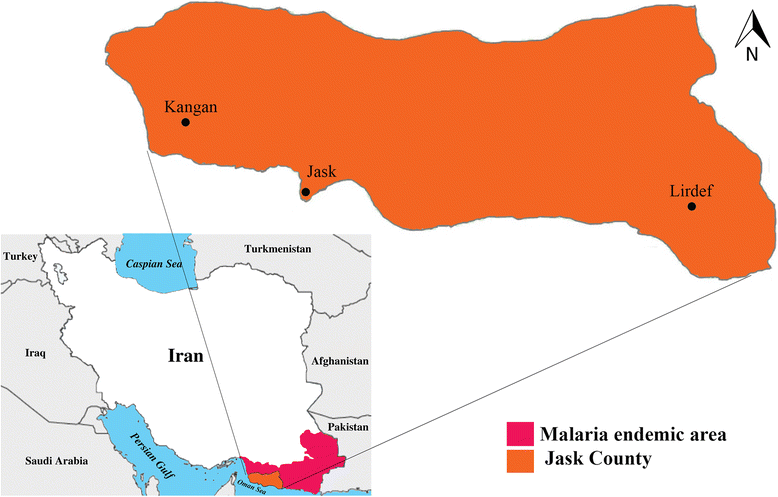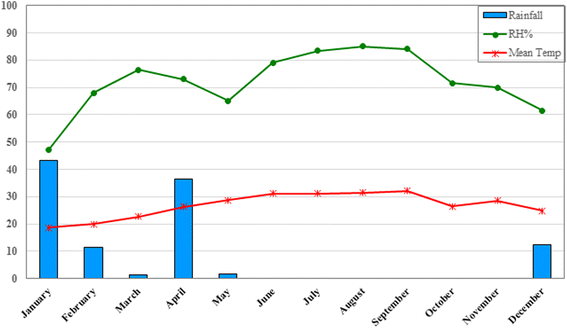Insecticide susceptibility of Anopheles stephensi to DDT and current insecticides in an elimination area in Iran
- PMID: 27809871
- PMCID: PMC5096305
- DOI: 10.1186/s13071-016-1851-4
Insecticide susceptibility of Anopheles stephensi to DDT and current insecticides in an elimination area in Iran
Abstract
Background: Iran has recently initiated a malaria elimination program with emphasis on vector control strategies which are heavily reliant on indoor residual spraying and long-lasting insecticidal nets. Insecticide resistance seriously threatens the efficacy of vector control strategies. This study was conducted to determine the insecticide susceptibility of Anopheles stephensi to DDT and current insecticides in Jask county as an active malaria focus in southeastern Iran.
Methods: In this study, the anopheline larvae were collected from different aquatic habitats in Jask county and transported to insectarium, fed with sugar and then 3-day-old adults were used for susceptibility tests. WHO insecticide susceptibility tests were performed with DDT (4 %), malathion (5 %), lambda-cyhalothrin (0.05 %), deltamethrin (0.05 %) and permethrin (0.75 %).
Results: The field strain of An. stephensi was found resistant to DDT and lambda-cyhalothrin. The LT50 values for DDT and lambda-cyhalothrin in this species were 130.25, and 37.71 min, respectively. Moreover, An. stephensi was completely susceptible to malathion and permethrin and tolerant to deltamethrin.
Conclusion: The present study results confirm the resistance of the major malaria vector, An. stephensi, to DDT and lambda-cyhalothrin, and tolerance to deltamethrin, which could gradually increase and spread into other malaria endemic areas. Thus, there is a need for regular monitoring of insecticide resistance in order to select suitable insecticides for vector control interventions towards malaria elimination.
Keywords: Anopheles stephensi; Insecticide resistance; Iran; Jask; Malaria.
Figures




Similar articles
-
Comparative performance of imagicides on Anopheles stephensi, main malaria vector in a malarious area, southern Iran.J Vector Borne Dis. 2008 Dec;45(4):307-12. J Vector Borne Dis. 2008. PMID: 19248658
-
Long-lasting residual efficacy of Actellic®300CS and Icon®10CS on different surfaces against Anopheles stephensi, an invasive malaria vector.Trop Med Int Health. 2024 Sep;29(9):781-791. doi: 10.1111/tmi.14028. Epub 2024 Jul 31. Trop Med Int Health. 2024. PMID: 39081142
-
Insecticide susceptibility status of malaria vectors, Anopheles culicifacies, Anopheles fluviatilis and Anopheles minimus in the tribal districts of Jharkhand state of India.J Vector Borne Dis. 2021 Oct-Dec;58(4):374-382. doi: 10.4103/0972-9062.325641. J Vector Borne Dis. 2021. PMID: 35381828
-
Evolution of insecticide resistance and its mechanisms in Anopheles stephensi in the WHO Eastern Mediterranean Region.Malar J. 2020 Jul 17;19(1):258. doi: 10.1186/s12936-020-03335-0. Malar J. 2020. PMID: 32680514 Free PMC article.
-
A systematic review of interventions targeting Anopheles stephensi.Wellcome Open Res. 2024 Dec 16;9:724. doi: 10.12688/wellcomeopenres.23480.1. eCollection 2024. Wellcome Open Res. 2024. PMID: 39844918 Free PMC article.
Cited by
-
Preliminary monitoring of knockdown resistance (kdr) mutation in Anopheles stephensi: insights from a malarious area in Southeastern Iran.Malar J. 2024 Jul 17;23(1):211. doi: 10.1186/s12936-024-05042-6. Malar J. 2024. PMID: 39020365 Free PMC article.
-
Household knowledge and practices concerning malaria and indoor residual spraying in an endemic area earmarked for malaria elimination in Iran.Parasit Vectors. 2017 Dec 6;10(1):600. doi: 10.1186/s13071-017-2548-z. Parasit Vectors. 2017. PMID: 29212553 Free PMC article.
-
Insecticide resistance in Anopheles stephensi in Somali Region, eastern Ethiopia.Malar J. 2020 May 12;19(1):180. doi: 10.1186/s12936-020-03252-2. Malar J. 2020. PMID: 32398055 Free PMC article.
-
Monitoring and Mapping of Insecticide Resistance in Medically Important Mosquitoes (Diptera: Culicidae) in Iran (2000-2020): A Review.J Arthropod Borne Dis. 2021 Mar 31;15(1):21-40. doi: 10.18502/jad.v15i1.6484. eCollection 2021 Mar. J Arthropod Borne Dis. 2021. PMID: 34277854 Free PMC article. Review.
-
Monitoring of synthetic insecticides resistance and mechanisms among malaria vector mosquitoes in Iran: A systematic review.Heliyon. 2022 Jan 24;8(1):e08830. doi: 10.1016/j.heliyon.2022.e08830. eCollection 2022 Jan. Heliyon. 2022. PMID: 35128113 Free PMC article. Review.
References
-
- Djadid ND, Forouzesh F, Karimi M, Raeisi A, Hassan-Zehi A, Zakeri S. Monitoring pyrethroid insecticide resistance in major malaria vector Anopheles culicifacies: comparison of molecular tools and conventional susceptibility test. Iran Biomed J. 2007;11(3):169–76. - PubMed
-
- WHO. World Malaria Report 2015. Geneva: World Health Organization; http://www.who.int/malaria/publications/world-malaria-report-2015/report.... Accessed 23 May 2016.
Publication types
MeSH terms
Substances
LinkOut - more resources
Full Text Sources
Other Literature Sources
Molecular Biology Databases
Miscellaneous

